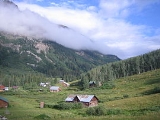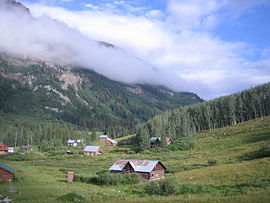
Rocky Mountain Biological Laboratory
Encyclopedia

Crested Butte
Crested Butte is a mountain peak butte of the Elk Mountains in the U.S. State of Colorado. It is also a town with a population of about 2000 people. The greater area includes Crested Butte, Mt. Crested Butte, Riverland, Riverbend, and Crested Butte South....
, in the West Elk mountains) It offers courses for undergraduate students - including National Science Foundation funded REU students and provides support for researchers from universities and colleges.
RMBL was founded in 1928 on the remains of an abandoned mining town in Gothic, Colorado. Approximately 160 people are in residence there during the summer field season. Over 1200 scientific publications have been based on work from the Laboratory.
The diversity and depth of research at the lab make the area around Gothic, Colorado a well-understood ecosystem. While scientists can use RMBL's facilitieshttp://www.nsf.gov/awardsearch/showAward.do?AwardNumber=0420910 to study any topics relevant to the ecosystems around the Lab, a number of particular research areas have emerged as topics of particular interests. Charles Remington, an influential figure in the study of butterflies, spent a number of years working on the genetics of butterflies at the Lab. A number of other scientists, such as Paul R. Ehrlich
Paul R. Ehrlich
Paul Ralph Ehrlich is an American biologist and educator who is the Bing Professor of Population Studies in the department of Biological Sciences at Stanford University and president of Stanford's Center for Conservation Biology. By training he is an entomologist specializing in Lepidoptera , but...
, Carol Boggshttp://www.stanford.edu/group/CCB/Staff/carol.htm, Ward Watt( President of the California Academy of Sciences http://www.calacademy.org/geninfo/newsroom/releases/2003/WardWattPresident03.html) , and Naomi Pierce
Naomi Pierce
Naomi E. Pierce is the Hessel Professor of Biology at Harvard University and a world authority on butterflies. Pierce is the university's Curator of Lepidoptery, a position once held by Vladimir Nabokov....
, have also spent time working on butterflies at the Lab.
Climate Change is another well-studied area at the RMBL fueled by researchers such as John Hartehttp://www.motherjones.com/news/feature/2004/07/07_406.htmlhttp://erg.berkeley.edu/erg/people/faculty/harte.shtml
who has been heating a Rocky Mountain meadow to measure what global warming might meanhttp://www.nwf.org/nationalwildlife/article.cfm?issueID=121&articleID=1576.
Pollination biology is another historical research strength of the lab. Since 'introduced honeybees' do not survive at higher elevations such as the RMBL, a number of scientists, including Nicholas Waserhttp://www.biology.ucr.edu/people/faculty/Waser.html, Mary Pricehttp://www.biology.ucr.edu/people/faculty/Price.html, James Thomsonhttp://labs.eeb.utoronto.ca/thomson/, Diane Campbellhttp://www.faculty.uci.edu/profile.cfm?faculty_id=2124, and David Inouyehttp://www.clfs.umd.edu/biology/faculty/inouye/inouye2.htm, who are interested in native pollination systems continue to work at the Lab.
The lab is home to one of the longest running mark-recapture studies of a non-game animal in the world. Ken Armitage started a study of yellow-bellied marmot
Yellow-bellied Marmot
The yellow-bellied marmot , also known as the rock chuck, is a ground squirrel in the marmot genus.-Description:...
s in 1962 and it has been continued by Dan Blumstein.
Stream ecology is another research focus. David Allan conducted work on streams around the lab in the 1970s. Barbara Peckarskyhttp://www.zoology.wisc.edu/faculty/Peckarsky/research.htm, one of the world's top stream ecologistshttp://www.jyi.org/volumes/volume6/issue1/features/demichele.html, has worked on the streams for 30+ years along with collaborators from around the worldhttp://www.zoology.wisc.edu/faculty/Peckarsky/people.htm.
A number of scientists who have had an influence on environmental policy http://rmbl.org/rockymountainbiolab/newsroom.html have also worked at the lab, including John P Holdren, http://www.lib.uci.edu/quest/index.php?page=holdren_bio President Obama's National Science Advisor http://harvardscience.harvard.edu/culture-society/articles/john-p-holdren-named-president-elect-obama-s-science-advisor, Ehrlich (author of The Population Bomb
The Population Bomb
The Population Bomb was a best-selling book written by Paul R. Ehrlich and his wife, Anne Ehrlich , in 1968. It warned of the mass starvation of humans in the 1970s and 1980s due to overpopulation, as well as other major societal upheavals, and advocated immediate action to limit population growth...
), Michael Soulé
Michael Soule
Michael E. Soulé is a U.S. biologist, best known for his work in promoting the idea of conservation biology. He earned a Ph.D. in Population Biology at Stanford University under Paul R. Ehrlich...
(founder of Conservation Biology
Conservation biology
Conservation biology is the scientific study of the nature and status of Earth's biodiversity with the aim of protecting species, their habitats, and ecosystems from excessive rates of extinction...
), John Cairnshttp://www.johncairns.net/ (member of the National Academy of Sciences
United States National Academy of Sciences
The National Academy of Sciences is a corporation in the United States whose members serve pro bono as "advisers to the nation on science, engineering, and medicine." As a national academy, new members of the organization are elected annually by current members, based on their distinguished and...
), and Theo Colborn (author of Our Stolen Future
Our Stolen Future
Our Stolen Future: Are We Threatening Our Fertility, Intelligence, and Survival? A Scientific Detective Story is a 1996 book by Theo Colborn, Dianne Dumanoski, and John Peterson Myers. The book chronicles the development of the endocrine disruptor hypothesis by Colborn...
).
RMBL is a member of the Organization of Biological Field Stations
Organization of Biological Field Stations
The Organization of Biological Field Stations is a nonprofit multinational organization representing the field stations and research centers across Canada, United States, and Central America. While it has no administrative or management control over its member stations, it helps to improve their...
.
External links
- Rocky Mountain Biological Laboratory official site
- http://www.cbweekly.com/page.cfm?pageid=2694
- http://www.tpl.org/tier3_cd.cfm?content_item_id=20633&folder_id=3228
- http://biome.utoronto.ca/forums/showthread.php?t=57299
- http://www.sciencestorm.com/award/9412945.html
- http://www.fs.fed.us/psw/mtnclim/program/
- http://www.rockymountainnews.com/drmn/local/article/0,1299,DRMN_15_4310959,00.html

